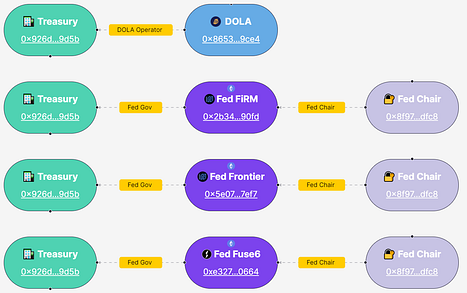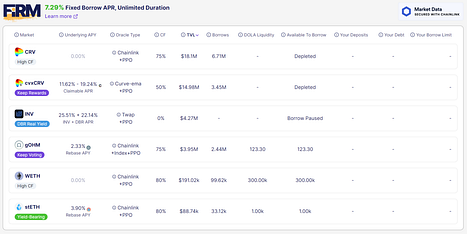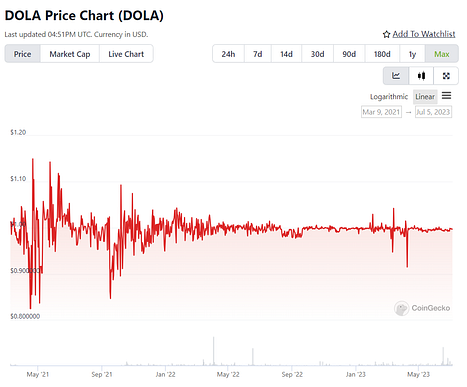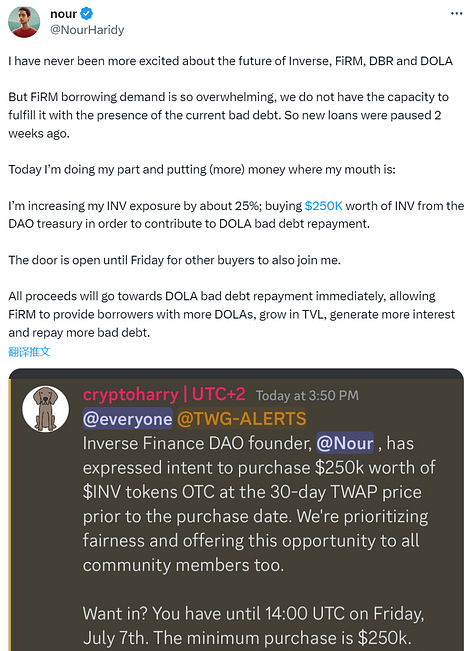Has Inverse Finance successfully transitioned from CDP lending products to fixed-rate lending markets?
Has Inverse Finance moved from CDP loans to fixed-rate lending markets?
1. Project Introduction
Inverse Finance is an Ethereum-based CDP lending product that allows users to borrow the stablecoin DOLA by collateralizing cryptocurrency. The project was founded in 2020 and gained market attention after being recommended by YFI founder AC. At that time, the project provided lossless investment opportunities around the stablecoin Dai. Users could deposit Dai in the protocol treasury and receive a deposit certificate inDai in a 1:1 ratio. The treasury would then put the Dai into yield aggregator protocols such as Yearn to earn rewards in ETH, YFI, and other tokens.
Unfortunately, the project suffered two consecutive malicious attacks in 2022, resulting in the product being suspended. In October 2022, the project pivoted to become a fixed-rate lending market.
2. Team
The only public member profile is the project founder Nour Haridy, who is from Egypt and has been a Web3 development engineer since 2018. Haridy has described himself as a developer in the Ethereum field for several years, mainly designing gas-free Dai smart wallets such as Metacash and Mosendo. Nour currently works full-time at Inverse Finance and has 28,000 Twitter followers, with a small social influence.
 Figure: Founder’s Twitter
Figure: Founder’s TwitterCrunchbase information shows that Inverse acquired Tonic Finance for $1.6 million on April 30, 2021.
- “Fortune” interview with Sister Wood: Will ARK win the first Bitcoin spot ETF?
- Lightning Labs launches AI Bitcoin tool that enables sending Bitcoin on the Lightning Network
- What is Bitcoin Recursive Mnemonic?
 Figure: Inverse Finance public profile
Figure: Inverse Finance public profile3. Product
The current main products of Inverse Finance are the fixed-rate lending market FiRM and the stablecoin DOLA.
1. DOLA
DOLA is a decentralized stablecoin issued by Inverse Finance, anchored to the US dollar at a 1:1 ratio, and managed by the Feds smart contract.
Note: Due to the prophesizing manipulation attack on Frontier (the frontend), DOLA currently has some bad debts, which are being actively paid off by the DAO. The frontend product has been abandoned.
The Feds smart contract is controlled by the Inverse DAO and is divided into three different types, but all are able to mint DOLA directly into the liquidity pool or lending market and extract and destroy DOLA to affect the stability of DOLA’s price.
 Figure: Feds Types
Figure: Feds TypesCross-collateralization Feds: Frontier & Fuse, where Frontier has now been deprecated.
Isolated-mode collateralized Feds: Known as the FiRM lending market, the FiRM market has a global DOLA limit and each asset market will also set a daily lending limit. We will introduce FiRM in more detail below.
AMM Feds: Provides liquidity to protocols such as Velo, Convex, Aura, etc.
2. FiRM
In February 2021, Inverse collaborated with Anchor to launch the stablecoin DOLA, but with the collapse of the Terra ecosystem and two attacks on Inverse, the existing product frontend has been disabled. In October 2022, Inverse launched the fixed-rate lending product FiRM.
FiRM is an over-collateralized lending product, with the same principle as other lending products. The reason it is called fixed-rate lending is that FiRM is based on DBR (DOLA Borrowing Right) fixed costs. Users must hold DBR to borrow DOLA in FiRM, and one DBR represents the cost of borrowing one DOLA for one year. By calculating the number of DBRs required per day based on the amount and duration of the loan, users can estimate the number of DBRs they need to pay and the cost of borrowing before taking out the loan. DBRs can be added to the wallet at any time to extend the loan term.

The initial distribution of DBR was airdropped: ① Each INV staker who remained in the frontend application before October 30, 2022, received 2,000 DBR; ② Completed the lottery activity and received up to 1,000 DBR.
DBRs can be traded on the secondary market, so an increase or decrease in demand for DBRs by borrowers may cause the price of DBRs to rise or fall. High demand will drive up the price of DBRs, which is good for investors, but it will increase the borrowing cost for borrowers, thereby reducing the attractiveness of FiRM borrowing and not being friendly to the development of the Inverse protocol. Therefore, Inverse launched DBR Streaming, which rewards INV stakers with DBR tokens. By pledging INV to FiRM, users can receive DBR token rewards, and the community can influence the price of DBRs and the borrowing cost of users by adjusting the emission of DBRs.
4. Fundamental Data
1. TVL
The current total value locked (TVL) is $51.81 million. After experiencing an attack, the TVL has not shown much growth. Starting on June 12th, the founder of Curve deposited CRV and cvxCRV into Inverse and borrowed stablecoin DOLA, which significantly boosted Inverse’s TVL and gradually attracted the attention of other market participants.
 Figure: TVL trend
Figure: TVL trend Currently, only the founder of Curve has deposited about 23.63 million CRV and 6.73 million cvxCRV, with a total value of about $24 million. They have borrowed approximately 7.98 million DOLA stablecoins, and their personal position ($16.08 million) accounts for 31% of Inverse’s TVL, which indicates that the development of Inverse protocol is deeply influenced by Curve.
 Figure: Curve founder’s account
Figure: Curve founder’s account FiRM has been operating in “protected mode,” so each asset type in the lending market has a daily borrowing limit and a total supply limit. The supported asset types currently include CRV, cvxCRV, gOHM, WETH, and stETH. Among them, CRV and cvxCRV are the largest asset types. According to a proposal from May 2023, the daily borrowing limit for the CRV market is 1 million DOLA, and the supply limit is 10 million DOLA. For the cvxCRV market, the daily borrowing limit is 500,000 DOLA, and the supply limit is 6 million DOLA. The combined borrowing scale of the two is 10.16 million, with a borrowing limit of 63.5%. Due to the rapid increase in the supply of these two assets, liquidity supply to their markets was suspended two weeks ago for safety reasons.
 Figure: FiRM lending market
Figure: FiRM lending market 2. DOLA
According to the official website, the total supply of DOLA is currently 61.8 million, of which 37.72 million are supplied on Ethereum, accounting for 61.04%, followed by Optimism, accounting for 30.44%. The main places of use are the DEX Velo on Optimism and its own protocol product FiRM. The DOLA team still attaches importance to the adoption of Layer 2.
 Figure: DOLA issuance scale
Figure: DOLA issuance scale  Figure: DOLA Distribution
Figure: DOLA DistributionAccording to defillama.com data, DOLA ranks 19th in market capitalization in the stablecoin market, accounting for only 1.4% of the market capitalization of DAI, the leading decentralized stablecoin.
 Figure: Stablecoin Market Capitalization Ranking
Figure: Stablecoin Market Capitalization RankingSince the “hacking” incident, DOLA’s token price has been relatively stable since October 2022. There have been two significant price fluctuations recently: one on March 8th, which was influenced by the USDC event, and another on April 9th, the cause of which is currently unknown.
 Figure: DOLA Price Trend
Figure: DOLA Price TrendV. Economic Model
There are three types of tokens in the Inverse protocol: DOLA, INV, and DBR. DOLA is the stablecoin product, which has been extensively described above. This section will focus on INV and DBR.
1. INV
INV is the governance token of Inverse, and currently, the only use of the token is staking and governance.
The complete economic model of INV is currently unknown. The token supply is issued by governance proposal voting, and the previous practice was to approve a minting proposal every quarter and determine the token emission amount according to the liquidity strategy. A new proposal on June 30th confirmed that 60,000 INV will be minted in the second half of 2023 for DAO operation in the next 3-6 months.
The current total token supply is 305,000, with a staking rate of 56.4%. 98,000 are staked through FiRM, and 74,000 are left over from the front-end staking. The Inverse front-end was abandoned in June 2022 due to the impact of a malicious attack.
 Figure: INV Token Supply
Figure: INV Token Supply2. DBR
DBR has no supply limit and is issued by the Inverse DAO. 13 million were issued and 12.72 million were burned over the past year. There are currently around 280,000 in circulation, and according to Coingecko data, the total supply of DBR is currently 4.646 million.
 Figure: Annual Supply and Destruction of DBR
Figure: Annual Supply and Destruction of DBRSince March of this year, the amount of DBR destroyed has significantly increased, and in June, due to the active CRV and cvxCRV asset markets, the amount of destruction was three times that of May, and the annualized destruction also exceeded the annual issuance, causing DBR to enter deflation.
Due to the increase in lending in the FiRM market, to meet the growing demand for DOLA lending, the community proposed to increase the DBR issuance from 10 million per year to 20 million per year.
 Figure: Monthly Supply and Destruction of DBR
Figure: Monthly Supply and Destruction of DBRFrom the consumption of DBR, it can be seen that the main demand in the near future is for the CRV market, followed by OHM, and 0x7a16 for Curve founder positions.
 Figure: Consumption of DBR
Figure: Consumption of DBR3. INV and DBR
DBR is a necessary consumable in the Inverse protocol, with a real demand scenario. The demand for DOLA lending will directly affect the price of DBR. The rise in the price of DBR means an increase in the cost of borrowing. In order to ensure the good development of the product and suppress the borrowing cost, the Inverse DAO will increase the emission of DBR, increase the supply of DBR, and thus reduce the price of DBR.
DBR is mainly produced by INV stakers, and the demand for DBR will encourage INV token holders to stake and empower INV tokens, the two complement each other.
6. Assets and Liabilities
1. Assets
The total value of assets held by the Treasury is $4.57 million, including $4.43 million held by the Treasury contract and $137,800 in Frontier reserves. Most of the assets in the Treasury contract are DOLA, worth $2.25 million, followed by DBR assets, worth $1.53 million.
 Figure: Treasury Asset Distribution
Figure: Treasury Asset Distribution2. Liabilities
Inverse Finance was attacked and lost 4,300 ETH, approximately $14.964 million, due to a vulnerability being exploited on April 2, 2022. It suffered a flash loan attack again on June 16, 2022, and lost approximately $1.2 million.
According to information disclosed by officials on Discord on June 28th, the current DOLA bad debts held are about 9.42 million US dollars, and the team has repaid 1.372 million US dollars since June 2022, including funds received from DWF and other entities OTC sales.
The team is also selling INV and DBR assets in order to repay bad debts. The latest information is as follows:
1. Newly proposed: mint 26 million DBRs and sell them to whitelisted buyers at a 15% discount from the DBR TWAP price provided on Coingecko, with a minimum transaction amount of $100,000 to qualify for the discount. This proposal was officially executed on July 3rd.
2. The founder announced on Twitter that he has purchased INV worth $250,000 from the Treasury at the 30-day TWAP price, which will be used to repay bad debts. Other buyers are welcome to purchase, and the OTC period will continue until July 7th.
 Figure: Founder Nour’s Twitter message
Figure: Founder Nour’s Twitter messageSummary: The main problem with Inverse currently is the large amount of bad debt from history. All protocol income and token sales are used to repay bad debts, which affects the expansion of the product. As Aave reduces its risk exposure to CRV, the founder of Curve has shifted some of the lending activity from Aave to Inverse, which has drawn attention in the market. Although the liquidity supply of CRV assets in Inverse has reached its limit, the TVL of Inverse is still steadily increasing, which means that the Inverse protocol is gradually being recognized by the market, a good development signal.
We will continue to update Blocking; if you have any questions or suggestions, please contact us!
Was this article helpful?
93 out of 132 found this helpful
Related articles
- How is the market searching for logic in the old-school DeFi as COMP and MKR continue to rise in recent days?
- In the first half of the year, it lagged behind BTC. What kind of “danger” and “opportunity” will ETH face in the second half of the year?
- Foresight Ventures: The Best Attempt at a Decentralized AI Marketplace
- 2023 Financing Semi-Annual Report: Primary Market Sluggish, Infrastructure and Tools Leading the Way
- Tether CTO: AI will choose Bitcoin over centralized cryptocurrencies
- Hong Kong has too many smart people, there are no more “leeks” in the currency circle.
- NFT’s Darkest Hour: Can These 24 Positive Developments Boost the Market?




